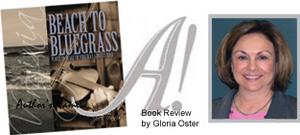

In Beach to Bluegrass: Places to Brake on Virginia's Longest Road, Joe Tennis takes readers on a leisurely trip down Route 58, a byway that runs from Hampton Roads to the Wilderness Road. This highway is the longest road in Virginia, and, as a road that runs the length of the bottom of the state, bisects Interstates 64, 95, 85, 77, and 81.
Reading the book nearly replicates the experience of exiting the whizzing traffic of the interstate on a whim to discover picturesque, quaint towns full of historical landmarks, slow-paced main streets, ice cream shops, and citizens ready to tell fascinating stories about the locale.
As Tennis travels Route 58, he recounts little-known history and trivia of each stop along the way, connecting these places, people, and events to milestones of Virginia's and America's distant and not-so-distant past. The book is divided into four major sections: Hampton Roads, Piedmont, Blue Ridge, and Southwest. Thus, the title forecasts the contrast in topography and history that a person witnesses traveling the length of Route 58.
The volume contains 58 stories, an important number for this book's purpose. All are short and quickly read; each is a snapshot of the character of the stopping point along the route. Many stories contain historical information, from the first landing near Virginia Beach of John Smith and his band of quarrelsome Englishmen in 1607 to the Civil War's Battle of Jonesville in 1864 -- nearly 500 miles away from the site of Smith's landing. The scope of Virginia's history is painted broadly. After each narrative, Tennis gives concise driving directions to the point of interest. Exiting an interstate at the appropriate point, earnest sightseers could easily access the story's focus.
The nuggets of discovery aren't all related to what history books might report. Some places have quirky stories that Tennis discloses and, if you aren't a resident of that area, you might never know. For example, did you know that Suffolk, Virginia, is the peanut capital of the world? Mr. Peanut, a familiar sight in his top hat and monocle, has a statue in Suffolk, honoring his longstanding reputation in the peanut world. Tennis begins this chapter:
"Mr. Peanut came out of his shell wearing a chef's hat. In another sketch, the cartoon goober
carried a lunch box that said "Planters." Suffolk teenager Antonio Gentile created this hand-drawn
character in 1916 and won five dollars when Mr. Peanut became the symbol of the Planters Nut &
Chocolate Company."
The style of this passage reflects the gentle wit that Tennis uses when the story warrants such humor and punning; the aforementioned Mr. Peanut saga was "boiled down" to its most important elements, of course.
In the Southwest section of the book, some tales -- like the haunting of the Martha Washington Inn and Robert Porterfield's vision in establishing the Barter Theatre -- are quite familiar for readers in this area. But others, like a thumbnail history of the Moonlite Drive-in and Sugar Hollow Park (a.k.a. Beaver Creek Lake on topography maps), have the capacity to surprise. Did you know that Bristol had a "Water Works War" in 1889? This war was a real-life "Border Bash" that thankfully had no casualties. Landmarks such as Bristol's Burger Bar and people like Maces Springs's Johnny Cash and June Carter occupy seats of distinction in Tennis's contribution to our region's local color.
Sharp photographs in both color and black-and-white are liberally sprinkled throughout the text; every story has at least one, some have two. The middle of the book features a 12-page section of color photos of notable places across the 500-mile stretch of Route 58. All photographs were taken by Tennis, except for the occasional historic portrait. The cover is clever and artsy, depicting in sepia tones a split image: on the left side a beach appears and on the right side a fiddler. Even though the book is a paperback, it has the look and feel of a small "coffee-table book." The quality of the slick paper contributes to the aesthetically pleasing experience of reading it as well. Tennis includes an extensive bibliography and a list of other resources, complete with website addresses.
Beach to Bluegrass entertains intelligently. For lovers of Virginia (including Virginians and others), this book will bring much delight, making Route 58 accessible either by couch or by car.
About the author
Joe Tennis, 38, was born in Virginia Beach, near U.S. 58, and now lives between Bristol and Abingdon, just off U.S. 58. An award-winning features writer for the Bristol Herald Courier, Tennis's articles have also appeared in Blue Ridge Country, Parkway Milepost, Winston Salem-Journal, Richmond Times-Dispatch and The Virginian-Pilot.
A graduate of Radford University, Tennis's previous books include 2004's Southwest Virginia Crossroads: An Almanac of Place Names and Places to See (The Overmountain Press) and 2007's The Marble and Other Ghost Tales of Tennessee and Virginia (Backyard Books). Tennis also contributed two chapters to V.N. "Bud" Phillips's 2006 history of Bristol, A Good Place to Live (The Overmountain Press).
-- CLICK HERE for a list of booksignings planned by Joe Tennis.
About the Reviewer:
Gloria Oster teaches in the School of Education at King College and is a member of the Arts Alliance Mountain Empire's A! Magazine for the Arts committee.